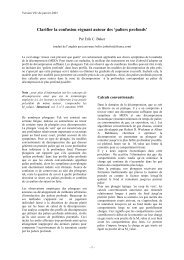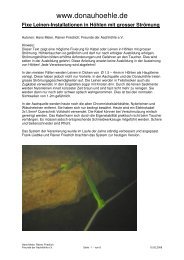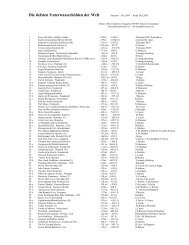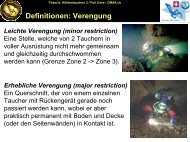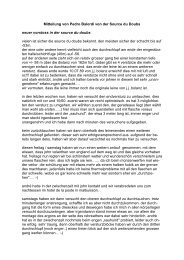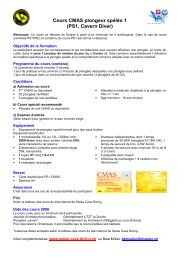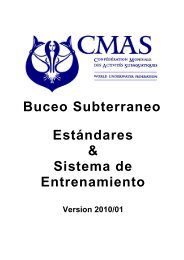cave diving and the nss - bei Swiss-Cave-Diving
cave diving and the nss - bei Swiss-Cave-Diving
cave diving and the nss - bei Swiss-Cave-Diving
You also want an ePaper? Increase the reach of your titles
YUMPU automatically turns print PDFs into web optimized ePapers that Google loves.
38 CAVE DIVING COMMUNICATIONS<br />
tions increased <strong>and</strong> passageways were found to be more complex,<br />
this procedure was ab<strong>and</strong>oned in favor of installing permanent<br />
guidelines.<br />
Once guidelines became permanent, <strong>the</strong> need for determining<br />
direction <strong>and</strong> estimated distances to nearby exits became paramount.<br />
At that time <strong>cave</strong> maps were little more than imaginative<br />
scratches on a note pad <strong>and</strong> each <strong>cave</strong> dive became a project unto<br />
itself. One of <strong>the</strong> first attempts to resolve this difficulty was a series<br />
of colored rings painted on <strong>the</strong> guideline at various intervals. But<br />
this idea was quickly ab<strong>and</strong>oned as <strong>the</strong> combination of colored<br />
marks was difficult to remember. Tanic acid also had a deleterious<br />
effect on <strong>the</strong> colors, <strong>and</strong>, as <strong>the</strong> marking system was strictly visual,<br />
localized silting could Fender <strong>the</strong> information useless. Lastly, this<br />
identification process was semipermanent <strong>and</strong> new discoveries<br />
often invalidated <strong>the</strong> information available.<br />
In <strong>the</strong> 1970's, Lewis Holtzendorff began to advocate <strong>the</strong> use<br />
of triangle-cut wedges of duct tape, hence <strong>the</strong> name Dorff Markers.<br />
These Dorff Markers could be easily attached to <strong>the</strong> diver's tanks<br />
<strong>and</strong>, with reasonable care, be installed on <strong>the</strong> line, pointing in <strong>the</strong><br />
direction of <strong>the</strong> nearest exit. With some markers <strong>the</strong> date of placement<br />
<strong>and</strong> a specific distance were also included. Some of <strong>the</strong>se<br />
Dorff Markers are still in place on lines in use today, but <strong>the</strong>y began<br />
to fall out of favor as <strong>the</strong> preferred marking system for several<br />
reasons. Chiefly, during a siltout, directional information was not<br />
clear. Fur<strong>the</strong>rmore, should <strong>the</strong> discovery of a new entrance warrant<br />
a change in <strong>the</strong> direction of a Dorff marker, <strong>the</strong> old marker<br />
could not be easily removed without damaging <strong>the</strong> guideline.<br />
Enterprising <strong>cave</strong> divers overcame<br />
<strong>the</strong>se shortcomings by cutting<br />
remnants of plastic <strong>and</strong> plexi-glass<br />
into triangular shapes for use as line<br />
arrows. Forrest Wilson, who was at<br />
that time Training Chairman of <strong>the</strong><br />
NSS-CDS, developed a method to<br />
mass produce <strong>the</strong>se plastic line arrows.<br />
Currently, arrows such as<br />
<strong>the</strong>se are an integral part of every<br />
<strong>cave</strong> diver's basic equipment, <strong>and</strong> are<br />
available in a variety of colors.<br />
PLASTIC LINE ARROWS<br />
REELS AND LINE MARKERS 39<br />
Line Markers<br />
Plastic line arrows are generally used to permanently mark a<br />
guideline. The "arrow" points toward <strong>the</strong> nearest exit. In many<br />
systems <strong>the</strong>se arrows point towards <strong>the</strong> nearest "practical," most<br />
easily accessible exit <strong>and</strong> not necessarily <strong>the</strong> geographically<br />
closest exit. For example, <strong>the</strong> nearest practical exit for a hypo<strong>the</strong>tical<br />
<strong>cave</strong> may be some 500 feet away from <strong>the</strong> placement of a line<br />
arrow through a spacious passageway. The true, or physically<br />
closest exit may be only 100 feet away from <strong>the</strong> line marker <strong>and</strong><br />
lie in <strong>the</strong> opposite direction, but it may involve passing through a<br />
series of extreme, equipment-removal restrictions. During an<br />
emergency, <strong>the</strong> fastest way out of <strong>the</strong> <strong>cave</strong> is likely to be <strong>the</strong> longer<br />
of <strong>the</strong> two routes.<br />
What constitutes an "extreme" restriction, or o<strong>the</strong>r reasons for<br />
pointing away from a nearby exit, is likely to be a subject of some<br />
debate among <strong>cave</strong> explorers. The point to remember is that plastic<br />
line arrows are used to permanently indicate <strong>the</strong> most direct, or<br />
fastest, route out of a <strong>cave</strong>. But one must exercise some common<br />
sense when reading installed line arrows. In most all cases <strong>the</strong><br />
arrows do point toward an exit, but in a very few instances <strong>the</strong><br />
arrows were installed incorrectly <strong>and</strong> point toward additional penetration.<br />
When entering a <strong>cave</strong> system, confirm that each line arrow<br />
Plastic Line Arrow<br />
Arrow or "point" always points<br />
toward exit. Always identify<br />
your arrows with your name<br />
or initials.<br />
Clo<strong>the</strong>spin<br />
Clo<strong>the</strong>sline clips should include,<br />
at least, <strong>the</strong> installer's initials as<br />
extra identification.




